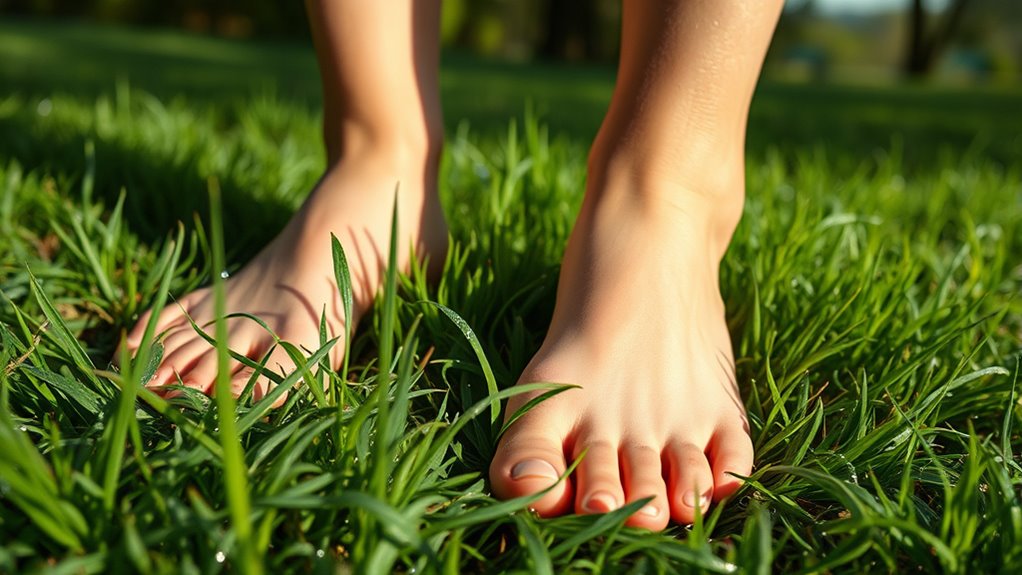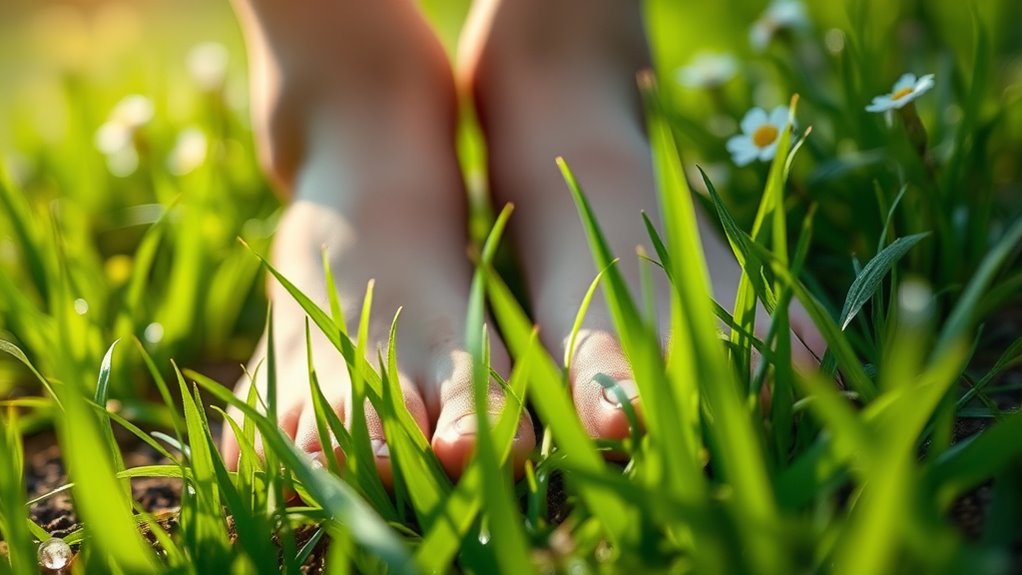Grounding, or earthing, involves making direct contact with the earth’s surface by walking barefoot or touching natural surfaces like grass or sand. This simple act helps your body absorb electrons, neutralize free radicals, and restore natural electrical balance. It relaxes your nervous system, reduces stress, and boosts mental clarity—giving you a quick mental and physical reset. Keep exploring how grounding can transform your day and support overall well-being by staying engaged.
Key Takeaways
- Touching natural surfaces like the floor or grass allows your body to absorb electrons, promoting electrical balance and reducing stress.
- Grounding relaxes the nervous system, shifting it from fight-or-flight to a calmer state, improving mental clarity.
- Simple contact with the earth can reset your body’s energy flow, enhancing mood and emotional resilience.
- Incorporating grounding into daily routines, such as walking barefoot or sitting outdoors, can improve overall well-being and mental focus.
- Grounding acts as a natural mental and physical reset, helping change your mood and outlook for a more positive day.

Have you ever wondered what grounding really is and why it’s so essential? Grounding, also known as earthing, involves direct contact with the earth’s surface—whether by walking barefoot, sitting on the ground, or touching natural surfaces like grass or sand. This simple act can profoundly impact your overall well-being, especially when it comes to maintaining energy balance and reducing stress. When you connect with the earth, you’re allowing your body to absorb electrons, which helps neutralize free radicals and restores your natural electrical state. This process supports your body’s energy flow, promoting a sense of vitality and equilibrium that might be missing during busy, overstimulating days.
By grounding yourself regularly, you can experience a noticeable shift in your stress levels. Stress relief becomes more accessible because touching the ground signals your nervous system to relax. It’s like a reset button for your mind and body, calming the sympathetic nervous system responsible for the fight-or-flight response. When you walk barefoot on natural surfaces, you’re not only reconnecting physically but also mentally, giving your brain a break from constant digital stimulation and mental clutter. This break helps clear your thoughts, improve mood, and foster a sense of calm that can last long after your grounding session ends. Think of it as a natural way to recharge your mental batteries, helping you face daily challenges with a clearer and more centered mindset.
Grounding relaxes your nervous system, clears mental clutter, and recharges your mind for better daily resilience.
The beauty of grounding lies in its simplicity. You don’t need any fancy equipment or complicated routines—just a few minutes of direct contact with the earth can make a difference. It’s especially effective if you incorporate it into your daily routine, whether during a morning walk, a lunch break, or before bed. As you do so, you’re not only balancing your energy but also giving yourself a chance to unwind and release accumulated tension. This practice encourages your body to restore its natural energy balance, which is essential for maintaining overall health and resilience. Additionally, engaging with natural surfaces can support oral health maintenance as part of a holistic approach to well-being.
In essence, grounding is a powerful, effortless way to improve your well-being. It reconnects you with nature, helping your body find its natural rhythm and harmony. So, next time you feel overwhelmed or sluggish, consider stepping outside, removing your shoes, and touching the earth. You might be surprised how quickly it can change your day, lift your mood, and restore your energy balance—all with just a simple act of touching the floor.
Frequently Asked Questions
Can Grounding Help With Chronic Pain?
If you’re wondering whether grounding can help with chronic pain, the answer might be yes. By making skin contact with the earth, you can reduce electromagnetic interference that disrupts your body’s natural electrical balance. This connection may decrease inflammation and improve your overall well-being. Regular grounding could help manage your pain, especially if electromagnetic interference is a contributing factor to your discomfort. Give it a try and see how it works for you.
Is Grounding Effective Outdoors or Indoors?
You might wonder if grounding techniques work better outdoors or indoors. Generally, grounding outdoors is more effective because environmental factors like natural surfaces—grass, soil, or sand—conduct electrons more efficiently. Indoors, surfaces like carpets or wood may reduce grounding effectiveness. To maximize benefits, try to connect with natural surfaces outside whenever possible, but indoor grounding can still help, especially with conductive mats or grounding cords.
How Long Should I Ground Each Day?
Many experts suggest that the recommended grounding time varies based on individual needs, but generally, spending about 20 to 30 minutes daily is beneficial. While some believe longer sessions can enhance benefits, even short durations help reset your body and mind. To maximize grounding duration, listen to your body and incorporate it into daily routines, aiming for consistency rather than length, so you can experience the positive effects more fully.
Are There Any Safety Concerns With Grounding?
When considering safety, there aren’t many concerns with grounding if you use proper grounding materials and follow electrical safety guidelines. Make certain your grounding equipment is certified and in good condition to prevent electrical hazards. Avoid grounding in wet or damp environments, and always follow manufacturer instructions. If unsure, consult a professional to guarantee you’re practicing safe grounding, reducing risks and maximizing benefits for your well-being.
Does Grounding Improve Mental Health?
Grounding can markedly improve your mental health by promoting stress reduction and emotional resilience. When you connect with the Earth, it helps calm your nervous system, reducing anxiety and improving mood. This simple act encourages mindfulness and grounding in the present moment, which can boost your overall well-being. By regularly practicing grounding, you may find it easier to handle daily stressors and build emotional resilience over time.
Conclusion
By simply touching the floor, you gently coax your mind to settle, like a leaf drifting onto calm water. This quiet act can soften the edges of a busy day, helping you find a peaceful center amid chaos. Think of grounding as a gentle handshake with the earth, offering reassurance and stability. Small steps like these can brighten your outlook, turning everyday moments into opportunities for calm, clarity, and renewed strength.









